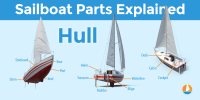Reading Sail Telltales Correctly (Main Sail, Shroud, Leech)
There are three main types of telltales: main sail, shroud, and leech. By knowing how to read all three, you'll be able to read the wind like never before. It's the best shortcut to improving your sail trim. Let's learn how to read them correctly.
If your telltales fly straight back, the sail trim is perfect, and you don't need to adjust anything. If the sail is luffing, it needs more wind, so ease it out slightly. If the sail is stalling, it is getting too much wind, so trim it in slightly. If the telltales are crossing each other, adjust the sail trim.
Telltales are the quickest way to master sail trim. Telltale whisperers tend to know exactly where to put their sails. Practice makes perfect; the more you use them, the easier it becomes to fine-tune your trim.
Summary
- Regularly check your telltales to help you understand how the wind is impacting your sails and guide you in making the necessary adjustments to achieve better sail trim.
- Keep observing your telltales and making adjustments to your sail trim until you've mastered the art of reading them.
- Keep an eye on both the windward and leeward telltales to ensure optimal sail trim.
- Adjusting sail trim based on the position of the telltales is a continuous process that requires constant attention and adjustment.

On this page:
How to Read Sail Telltales
Here's a table briefing about the different positions of the different telltales, what they mean, and how you should adjust your sail.
| Position of the Telltales | Meaning | Adjustment |
|---|---|---|
| Flying straight back | it means that the sail is trimmed correctly and the wind is flowing smoothly over the sail | no adjustment is needed |
| Luffing (top telltale is lifting up or fluttering) | it means that the sail is luffing, or not getting enough wind | ease the sail out slightly or point the boat more into the wind |
| Stalling (bottom telltale is not lifting up) | it means that the sail is stalling, or getting too much wind | trim the sail in slightly or point the boat more away from the wind |
| Crossing (top and bottom telltales are crossing each other) | it means that the sail is twisted or the wind is gusting | adjust the sail trim to remove the twist or steer the boat to a different angle to avoid the gusts |
Reading Main Sail Telltales
Main sail telltales are typically attached near the luff of the sail. By observing their behavior, you can determine whether you should sheet in the jib or turn the boat away from the fluttering telltale. When the windward telltale is fluttering, it means you need to either sheet in the jib or bear away until it stops and flows smoothly.
Position and alignment of your main sail telltales
Yarn telltales are typically used, and they should be attached to both sides of the sail. Position your telltales about one-third of the way from the luff and two-thirds up from the foot of the sail. This placement will give you a good overview of the airflow over the sail's surface.
Make sure that your telltales are properly aligned with each other. A straightforward way to achieve this is by attaching them to a seam or batten pocket. Aligning your telltales horizontally will help you more easily assess the sail's performance at a glance.
Luffing and flowing of your main sail telltales
Luffing occurs when the airflow over the sail is not efficiently attached, causing turbulence, that makes the telltales flutter or droop. When the airflow is smooth and attached to the sail, the telltales will flow neatly.
Monitor the windward and leeward telltales. If you notice the windward telltale luffing, it is an indication to sheet in the mainsail or bear away slightly. On the contrary, if the leeward telltale is luffing, it means that your boat is pointing too high, and you should sheet out the mainsail or head up slightly to improve airflow.
Reading Shroud Telltales

Shroud telltales are useful for spotting wind shifts and can provide valuable information to make quick adjustments. In this section, we will discuss the visual indicators to look for, as well as the differences between the windward and leeward sides.
Usually placed on both port and starboard stays, shroud telltales inform you about the wind flow across the deck. To use them effectively, pay attention to whether they are streaming aft or flapping. If they are streaming aft, your boat is in good trim. If they are flapping, you may need to adjust your sail or course to improve airflow over the boat.
Visual indicators on your shroud telltales
When observing shroud telltales, pay attention to their movement as they respond to the wind. Shroud telltales are better than luff telltales (on the jib or mainsail) for spotting shifts, as they react instantly, and give you an idea of the shift's magnitude. Make sure the telltales are made from ribbon, as this material provides better visibility and responsiveness.
Windward and leeward sides of shroud telltales
Understanding the difference between the windward and leeward sides when reading shroud telltales can have a significant impact on your sailing performance. A discussion on SailNet Community notes that:
Shroud telltales are most useful when sailing downwind (DDW). On the windward side, the shroud receives relatively undisturbed air, giving you a more accurate reading of the wind's direction and shifts.
Upwind, however, you should rely more on jib luff telltales, as the air around the shrouds is disturbed and less informative. The key here is to have the ability to see them, ideally through a window, so you can always monitor at least one of the leeward telltales.
Reading Leech Telltales

Leech telltales are located off the leech of the sail. They provide valuable information about how the wind is exiting the sail. When the jib is trimmed too tightly for the wind to travel around, you'll see the leech telltale fluttering and stalling. Adjust your sail trim appropriately to correct this issue.
Shape and twist of your sail
When it comes to reading leech telltales, the key is to look for the shape and twist of your sail. The leech telltales should be flowing aft, indicating that the air is flowing smoothly over the sail. There should be a smooth transition in twist from the bottom of the sail to the top. To achieve this, observe the leech telltales on different parts of the sail and adjust your sail trim accordingly. Make sure that the telltales are not stalled on one side or fluttering back and forth, which would indicate poor sail trim.
Achieving optimal trim of your sail
In order to achieve optimal trim, you must find the right balance between tension on the leech and tension on the luff of the sail. Here are a few tips to help you:
- Sail on a close reach: Position your boat on a close-reaching point of sail. Adjust your sailing angle and trim your sails to balance the boat to the point where it steers itself with minimal assistance. Do not use an autopilot; steer your boat by hand.
- Watch the mainsail telltales: The mainsail leech telltales should be flowing aft. If they are not, make adjustments to your sail, either by easing it out or tightening it, until they start streaming aft.
- Observe windward and leeward telltales: Both the windward and leeward telltales should be flying horizontally. If the windward telltale is lifting, you may need to trim in your sail. If the leeward telltale is lifting, try easing the sheet out to optimize airflow over the sail.
- Adjust for sail twist: On a reach, you might need to compromise the trim for different parts of the sail. The middle telltales should fly straight aft, while the top inside telltale might lift a bit, and the bottom outside telltale might hang down, indicating stalled flow at the bottom of the sail. Make adjustments to your sail controls to balance the twist and flow.
Adjusting Sails Based on Telltales

Mainsail controls for sail adjustment
To use your telltales effectively on your mainsail, start by paying close attention to the yarn or sailcloth near the luff of the sail. If the windward telltale is fluttering, either sheet in the jib towards the telltale or bear away from it until it stops fluttering and flows smoothly, as advised by US Sailing.
When both your windward and leeward telltales are streaming aft, you can tell that your mainsail is trimmed properly. However, if only one telltale is streaming aft while the other is stalled or drooping, adjust your sail controls until both telltales flow smoothly.
Fine-tuning strategies on the mainsail
Fine-tuning your mainsail is all about making small adjustments to maximize efficiency. For example, if your top telltale isn't flowing, try moving the lead position outboard and slightly forward. This will help the sheet pull down on the clew and close down the top sections of the sail, improving air flow.
When sail conditions or wind direction change, it's crucial to make adjustments to the outhaul, cunningham, and boom vang to maintain an efficient sail shape. Keep a close eye on your telltales as you tweak these controls, and soon, you'll become better at "reading" your telltales and making the right adjustments for optimal sail performance.
Common Telltale Mistakes and How to Avoid Them

Reading sail telltales accurately is essential for optimizing your boat's performance. However, it's not uncommon to make mistakes when interpreting their behavior. In this section, we'll discuss some common errors and offer tips on how to avoid them.
-
Ignoring the bottom telltales: One typical mistake is not paying attention to the bottom telltales on your sails. These lower telltales are especially important for the helmsman, as they help guide steering and sail trim decisions. Make sure you're regularly checking these telltales to maintain optimal sail trim.
-
Misinterpreting telltale behavior: For example, when sailing close-hauled, if the windward telltale lifts, it indicates your sail is trimmed too tightly, or you're pointing too high into the wind. Conversely, a lifting leeward telltale suggests the sail is too loose, or you're falling off the wind. To avoid misinterpretation, familiarize yourself with telltale behaviors and adjust your sailing techniques accordingly.
-
Focusing only on main sail telltales: When reading telltales, it's easy to focus exclusively on the main sail and forget about the importance of the shroud and leech telltales. These telltales provide additional information about air flow around your sails and help optimize sail shape. Remember to regularly check these telltales to ensure your sails are performing efficiently.
-
Not adjusting telltales for different points of sail: It's important to remember that telltales are most effective when sailing upwind or on a close-hauled course. Downwind or on a run, they become less relevant due to turbulent air flow. Adjust your expectations accordingly and rely on other indicators, like boat speed and apparent wind angle, when sailing on different points of sail.
Did you find the answer to your specific question?
👍 3 👎 2



Leave a comment